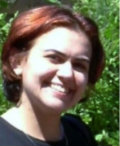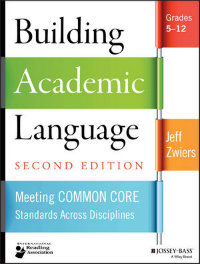The What, Why & How of Academic Language
Building Academic Language, Second Edition: Meeting Common Core Standards Across Disciplines
By Jeff Zwiers
(Wiley/Jossey-Bass, 2014 – Learn more)

In Building Academic Language, Jeff Zwiers sets out to define and explain academic language, and then illustrate how teachers can and should work to improve it throughout their instruction for upper-elementary to secondary students.
Preview: This book’s focus in not lists of content-related words. Much like the reading- and writing-across-the-curriculum movements, Zwiers calls on teachers of math, science, and social studies, as well as language arts, to become aware of the elements of academic language in their particular disciplines, and to develop students’ academic reading, writing, and discussion skills.
Calling academic language “the lifeblood of learning in all classes,” Zwiers describes how focusing on language use will lead to improved student achievement (xi). And of course, elements of curriculum standards – most frequently the Common Core State Standards – are woven throughout.

Calling them “diverse learners” or “diverse students,” Zwiers aims much of this book squarely at them and their teachers. This is not to say that students with special needs or those from mainstream backgrounds will not benefit from teachers’ use of the ideas here, but one overarching vision of the book is to level the playing field of and with school language.
A challenge for all students
Zwiers’ other thrust is that all students are facing greater cognitive demands – both in school and in future workplaces – and that an increased focus on academic language will benefit everyone.
The lessons and activities described in the second half of the book are not categorized according to levels of student achievement or language experience; it is up to teachers to determine how best to weave academic language teaching into content instruction. For that, teachers must have a strong understanding of academic language in general and its particular features and elements in their particular field.
In the first chapter, Zwiers uses a sociocultural lens to describe how academic language differs from the home or community language of many students. Issues of power, validation, and invisible criteria of school language are highlighted and will be familiar to readers of Delpit, Macedo and Freire. Ultimately, Zwiers advocates accepting and valuing language skills that students have when they come to us and explicitly teaching ones that will allow them to meet mainstream expectations.
What it is and why it matters
In Chapter 2, Zwiers defines, describes, and defends academic language, “the set of words, grammar, and discourse strategies used to describe complex ideas, higher-order thinking processes, and abstract concepts” (22). It includes smaller words and conventions that tie together content area vocabulary.
Although the text purports to be for teachers of all subjects, I imagine the language arts teachers and literacy coaches among us may be called into action to assist others in understanding elements such as modals and nominalization. And although occasionally veering into grammar-lesson territory, Zwiers does a good job demonstrating how such features function, particularly in history and science writing, and why they need to be taught explicitly.
Is this knowledge an additional layer for teachers to consider? Absolutely, but as Zwiers argues in the preface and throughout the book, “all teachers should become what I call practical educational linguists. We must know about the basic inner workings of language in our discipline and put this knowledge into practice in our classrooms” (xii).
The third chapter is a hodgepodge of content, ranging from language acquisition to think-aloud models to metadiscussions. The most valuable elements are expanded upon further in later chapters. Chapter 4 includes in-depth examples of academic language in language arts, science, social studies, and math. The respective sections could be good starting points for department-level discussions.
Also helpful are the tables of academic expressions for various skills, such as interpretation in language arts or problem solving in math. These examples will help teachers think about how meaning is revealed and how they can help students find it.
Helping students grasp academic language
The remaining half of the book focuses on procedures and examples for teaching students both how to comprehend academic language and how to produce it in discussions – from whole-class to partners – as well as reading and writing.
Zwiers promotes a great deal of teacher modeling to make academic language visible to students. Another method is utilizing metadiscussions and metareading to focus on how learning is occurring. Metadiscussions (discussions about discussions) can lead to a greater focus on the quality of talk about a classroom subject, while metareading helps students see how writers use language in academic ways.
In addition to language use, Zwiers emphasizes academic collaboration in the two discussion chapters. Many of the activities described will be familiar to teachers, echoing Kagan’s cooperative learning and Wilhelm’s action strategies, but it is interesting to see more language-focused elements in them.
The academic reading chapter addresses text organization, figurative language, long sentences, and vocabulary instruction. Zwiers emphasizes that students must be expected to produce complex academic texts in order to solidify content learning as well as language use. The writing chapter includes an in-depth look at argument writing as well as ideas for low-pressure writing tasks. All areas come together in an academic word wall, where a class collects content words, general academic words, discussion terms, and terms for writing.
At this point, most teachers are going to have several ideas for integrating academic language instruction and use into their content instruction. The final major chapter focuses on lesson planning and assessment and includes some good examples and rubrics, but not much new information.
Neither simple nor quick
Building Academic Language is a dense and sometimes challenging read. With the layers of subject knowledge and linguistic awareness required, academic language education is neither simple nor quick. Zwiers argues that it must be addressed throughout and within content instruction. He provides numerous starting points for becoming aware of academic language conditions and for helping students navigate school reading, writing, and discussion.
While there are no quick take-away lessons, there are plentiful suggestions for making academic language perceptible and useful to students. Much depends upon teacher modeling and teachers will need to be very familiar with both the content being taught and the language used to convey it, in order to be able to communicate it to students and then guide them to use academic language themselves.
Mara Southorn has been a reading specialist at Hill Middle School in Naperville, Illinois, for ten years. Prior to that, she taught high school reading and English in Colorado. She has master’s degrees from the Reading Specialist program at Teachers College, Columbia University, and the Graduate School of Library and Information Science at the University of Illinois. Her goal is to help students become independent readers, writers, and thinkers.






























